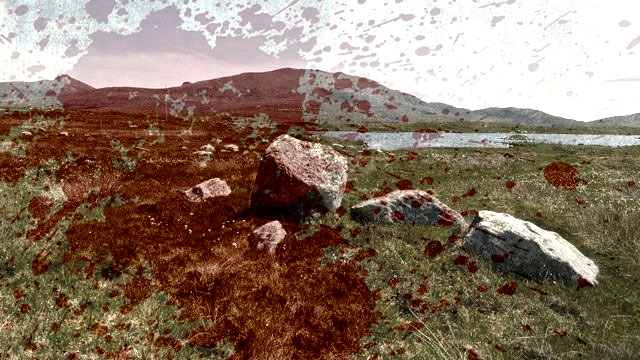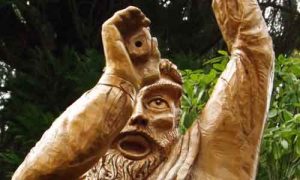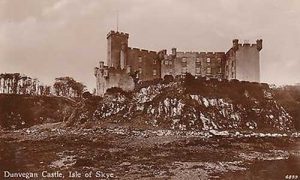From the dawn of time, or so it seems, tales have abounded of nasty killings in the Scottish Highlands and Hebridean Islands. As M J STEEL COLLINS shows, things didn’t calm down much in the 19th Century.

“I’m gone, take hold of the man!”
Following Culloden, the subsequent suppression of Gaelic culture saw the British Military stationed around the Highlands and Islands to keep the natives under control.
The army was still to be found there in the early 19th century. On 2 June 1812, in Chapeltown, Ballindalloch, near Glenlivet, one Captain Charles Munro of the 42nd Highlands, aka The Blackwatch, was in the shop of George Thompson, when he got into a row with Robert Ferguson, a ship carpenter. Ferguson called the Captain “a damned bugger”, and hurled various other insults; Captain Munro took Ferguson by the collar and propelled him out of the shop.
A few moments later, Ferguson returned with a knife and attacked Captain Munro without warning, inflicting a small, but deep wound in the soldier’s side, from which his guts protruded.
Captain Munro managed to hit his attacker on the knuckles with his cane, but was done for. He knew this, as he followed Ferguson outside the shop, holding his intestines in and shouting, “I’m gone, take hold of the man!” It might have been the case that everyone was in shock, as it wasn’t until the Captain called out. “Why don’t you seize the murderer?” and Ferguson tried to beat a hasty exit, that someone finally pounced on Ferguson. Captain Munro was taken to a house in Chapeltown, where he was treated by Dr George MacDonald of Comarty.
The soldier was dead 28 hours later. Ferguson was charged with the murder, and found guilty at his trial at the Inverness Circuit Court. Sentenced to death, Ferguson was hanged that October and his body given over for dissection by anatomists.
Peat Reek To Die For
In the early decades of the 19th century, illicit whisky distilling was in full swing in the Highlands and Islands, with both the Excisemen and illegal brewers constantly at odds with each other.
The unlicensed whisky was known as peat reek, and did a roaring trade with drinkers put off by the higher price of licensed whisky. Skirmishes between law enforcement and moonshiners got nasty quickly, as evidenced on 21 February 1821 near Nairn, when John MacKenzie, a farmer, and his son, escorting a cart loaded with illegal whisky, walked into Exciseman David Munro and his associate, George MacKay.
Munro demanded a search of the MacKenzie’s cart, which was steadfastly refused, and a fight broke out, which ended with George MacKay hitting John MacKenzie hard on the head with his stick.
The farmer collapsed and subsequently died the next day. MacKay was charged, but found Not Guilty.
Death Of A Pedlar
Murdoch Grant was a weel kent face thanks to his work as a pedlar, an important job, in which the far flung populace of the Scottish Highlands, unable to access shops, were supplied with goods and essentials.
Grant was working in Assynt, Sutherland, when he vanished in March 1830. He was a familiar figure, in his tartan clothes and bonnet. Four weeks after the Lochbroom native’s disappearance, a body was noticed floating in the waters of Loch Torr na h Eigen; most of the local residents of the surrounding area were on the scene to watch what was happening by time the carcase was hauled from the water. Though the head was badly battered, the body was identified as that of Murdoch Grant due to the clothes it had on. His pack was missing, something that just about never happened with a pedlar.
Murder was immediately suspected by many, including a local minister, and there was much speculation as to how Grant could have fallen into the water.
The missing pack contained a large amount of money and goods. The locals turned to local school teacher, Hugh MacLeod, who surmised that Murdoch Grant had just tripped, struck his head, fell into the Loch and drowned, but several people were convinced it was murder.
Owing to a lack of police in the area, the ancient tradition of Ordeal By Touch, whereby the corpse of a murder victim was believed to bleed if touched by the killer, was resorted to. Nobody batted an eyelid when Hugh MacLeod refused to take part, scoffing at the superstition. Murdoch Grant was laid to rest.
Everyone else might have tried to move on, but Grant’s brother, Alexander, wasn’t satisfied and set out to prove what had happened, searching around Loch Torr na h Eigen for the missing pack and pushing the authorities to exhume Murdoch’s body for further investigation.
The pack was located after a local seer Kenneth Fraser, aka Kenneth the Dreamer, reported seeing the pack lying under a cairn of stones in a Second Sight vision.
The description was so precise, that the cairn was recognised and the dead man’s scattered possessions found lying round about it. Meanwhile, Hugh MacLeod, previously skint, was spending money like no tomorrow, even stranger, given he had given up teaching. Suspicion soon fell on the ex-teacher, and he was taken to Dornoch Jail. On being searched, Murdoch Grant’s stockings were taken from MacLeod.
They were recognised as Grant’s by the old woman who had knitted them for the dead pedlar. More incriminating evidence was found at MacLeod’s home, where Grant’s tartan trousers and a blood covered hammer were located. The net further closed in, when several people reported MacLeod’s suspicious behaviour around the time of the murder.
In the end, the ex-teacher was found guilty of murder Murdoch Grant, and sentenced to death, though MacLeod continued to deny it. However, as his execution approached, MacLeod confessed to the murder, admitting battering the pedlar with a hammer after getting Grant to meet him near Loch on the pretext of buying all the pedlar’s goods. MacLeod was hanged on 24 October 1830 at Inverness.
Benbecula Horror
The quiet community of the Hebridean island Benbecula were shocked in 1857 when the mutilated body of local pauper, Mary Macphee was found lying in her bed, a blood smeared pair of handcuffs lying nearby.
The similarly mutilated bodies of Mary Macphee’s relatives, Angus Macphee and his wife Catherine Macinnes were found in the neighbouring house. Their mentally unstable son, also known as Angus was suspected, and a manhunt commenced.
Angus had recently been dismissed from his job as a farm worker on South Uist, and returned to his parents. The family had noticed the 24 year old’s behaviour was becoming unstable, and for everyone’s safety, had the local blacksmith forge the handcuffs, which were placed on young Angus when he became dangerous.
He hated the handcuffs and it appeared he had just snapped during one of his fits, in which it was thought his aunt tried to shackle him. Angus was found sitting on a rock on a small island in one of Benbecula’s many lochs, clutching a spade.
The rumour mill had it that he planned to kill the blacksmith who made his handcuffs. Locals persuaded Angus to give himself up, and he was later committed to an asylum.
The Heather Bell Murder
Scottish fishermen have a historic reputation for being a cantankerous and garrulous lot, frequently in trouble with the law. But some instances were just that bit more brutal than the norm. T
he Heather Bell was a fishing boat crewed by William Scott, his son James, James Smith and William McDonald, and plied the fishing off Lewis.
On 26 June 1874, the crew stopped at the Isle of Mull and paid a visit to a Tobermory pub for several drams. After a few, the elderly William Scott and James Smith started rowing over the working of the Heather Bell, though by time the men made it back to the boat, it appeared that the argument had been forgotten.
The boat left Tobermory in the company of another vessel named, somewhat ironically, William and James, making good headway on their journey. James Scott went below to sleep off the effects of the whisky, whilst his father steered and the other two men managed the sails. Things quickly went awry.
William MacDonald was smacked in the face by the halyard, drawing blood, then James Smith and William Scott began bickering again, this time over the Heather Bell’s steering.
William Scott ordered the younger man to go and have some sleep, but Smith disagreed, insisting he took over the steering. He then punched the much older Scott on the side of his head, to the horror of William MacDonald, who was still working the sails and asked the ‘what sort of work’ his crewmates were at.
James Smith responded by picking William Scott up by an arm and a leg, hurling the old man overboard and into the waves. MacDonald ran below deck to rouse James Scott, but found him in a deep slumber, so returned above, where he saw William Scott floating nearby, astern of the boat.
William MacDonald tried to rescue his crew mate by turning the boat around, closer to the old man. But he simply sank, apparently unconscious, and was never seen again. James Smith, meanwhile, had gone below deck, and returned 30 minutes later, working the sails. William MacDonald was in shock, but neither man spoke of what happened.
Later, James Scott emerged, asking where his father was, to be told by Smith that the old man had boarded the William and James, whilst MacDonald, perhaps still stunned at what he had seen, simply said he didn’t know what happened.
Upon entering the Caledonian Canal, James Smith told MacDonald he should say what had happened, but to blur the truth and state that the older Scott had simply fallen overboard. MacDonald did just that. James Scott had already noted the blood on MacDonald’s face, from when the halyard hit him and believed MacDonald had rowed with William Scott.
James Scott said as much when reporting his father’s disappearance to the police, but when telling the Procurator Fiscal what happened, stated that it was in fact James Scott who pushed the old man overboard, and Scott was subsequently charged with the murder.
Later in court, James Scott said that his father had told him that it had been William MacDonald with whom he had rowed, not James Smith, and was biding his time to get payback. Smith was found Not Guilty owing to the conflicting evidence and technically, the case is still unsolved.






